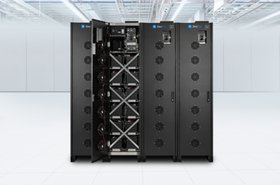Data center reliability and resilience are non-negotiable. These facilities, which house vital digital assets and support critical business operations, must maintain high uptime to meet the demands of an increasingly connected world.
At the heart of this reliability is the center’s uninterruptible power supply (UPS) system, which ensures consistent power flow and protects against potentially catastrophic downtime.
A UPS system failure can lead to significant financial losses, damage to equipment, loss of data, and erosion of customer trust. According to the Uptime Institute, more than two-thirds of all outages cost data centers over $100,000.
Backup power systems have another increasingly urgent imperative: sustainability. Investors, customers, and regulators are exerting pressure on industries, including the data center sector, to adopt environmentally friendly practices and ultimately achieve net zero GHG emissions.
The failure to embrace sustainability carries risks that extend beyond environmental harm. Reputational damage, regulatory penalties, and loss of business from eco-conscious clients can all impact the bottom line.
Conversely, the adoption of sustainable practices can enhance a company's reputation, attract investment, and provide a competitive edge in an increasingly green market. Sustainable UPS systems can help data centers achieve these goals by reducing their environmental impact.
So how can UPS systems be made more sustainable? One key lies in the choice of batteries used in these systems. Traditional UPS systems often rely on valve-regulated lead-acid (VRLA) batteries.
While these technologies have long been considered a standard, alternative battery chemistries can offer a path to more sustainable UPS systems, taking into consideration a variety of characteristics:
● Material use: The materials used in different battery chemistries vary in their lifecycle environmental impact. For instance, nickel and zinc are safe and abundant materials that mitigate battery hazards, health risks, and scarcity concerns compared to the lead and lithium used in lead-acid and lithium batteries. This advantage carries through to the end of the battery lifecycle; recycling nickel and zinc batteries uses less energy than lead, which requires energy-intensive high heat smelting.
● Greenhouse gas (GHG) emissions: The production, use, and disposal of batteries all contribute to GHG emissions, which drive climate change. Certain battery chemistries and designs, such as nickel-zinc batteries, have a lower manufacturing carbon footprint than other battery types. They’re also energy-efficient with a long lifespan, further reducing these emissions.
● Carbon payback time: This is the time it takes for a product to 'pay back' the carbon emitted during its production through its operational life. A shorter carbon payback time means the product used less carbon in its manufacture and is more beneficial for the environment.
● Volatile organic compounds (VOCs): VOCs are often used during the production of batteries and can contribute to air pollution and health problems. Batteries that minimize the use of VOCs in their production processes are more sustainable.
● Water footprint: This refers to the total volume of freshwater used to produce a product. Battery manufacturing can be water-intensive, so choosing batteries that prioritize water efficiency in their manufacturing processes contributes to their sustainability.
● Energy footprint: This is the total energy consumed over a product’s lifecycle, including its manufacturing process. The less energy used over the battery’s lifecycle, the lower its energy footprint and the more environmentally friendly it is.
These characteristics play a crucial role in determining the sustainability of UPS batteries in data centers. By understanding these factors, data center operators can make informed choices that favor sustainability, reducing their environmental impact while maintaining reliable power supply.
For instance, nickel-zinc (NiZn) batteries fulfill all these requirements by using abundant raw materials with a low carbon manufacturing footprint, yielding a shorter carbon payback time than lead-acid and lithium-ion batteries.
Over their lifetime, nickel-zinc batteries use 95 percent less water than lithium batteries, and 22-33 percent less energy than lithium-ion and lead batteries.
Data center operators including Corscale and Wyoming Hyperscale have chosen to utilize NiZn-powered UPS systems for their facilities, driven in large part by their sustainability metrics.
According to Boundless Impact Research and Analytics’ analysis, nickel-zinc batteries have achieved the highest climate rating of 9.4 out of 10, making them an ideal option for data centers looking to reduce their scope 3 emissions and reach their sustainability goals.
Considering sustainability when implementing resilience strategies is not just good for the environment – it's good for business. Environmental responsibility is becoming a necessity rather than a choice.
By choosing sustainable UPS energy storage systems, data centers can improve their environmental performance, meet growing stakeholder expectations, and ensure their operations remain resilient and reliable.
More from ZincFive
-

ABB adds ZincFive nickel-zinc batteries to UPS systems
Says nickel-zinc is a greener alternative to lead-acid and lithium-ion
-

Sponsored “Safe enough” is not safe: Assessing battery tradeoffs in data centers
And why nickel-zinc ensures safety comes first
-

Sponsored Making the most of your modular data center power system
Maximizing the potential of your prefabricated modular data center


